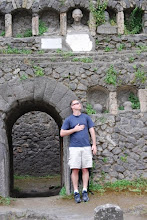First, what is a geyser? Geysers are hot springs, all named after a specific hot spring called Geysir, in Iceland, which I wish meant "geyser" in Icelandic, but apparently means "erupter" or "gusher." Technically, they don't have to be hot, but also none of that for now.
Geysers are hot springs that discharge great amount of water intermittently or periodically. The level of the eruption doesn't seem to matter--some are as little as a foot high--but the periodic nature seems to be. Oddly, the literature dismissively refers to hot springs that constantly spew forth great amounts of water as "'just' perpetual spouters." Like doing shooting water into the air 24/7 is easy; what's hard is stopping. Perpetual spouters suffer from their great consistency. But if they stop every once in a while, they're geysers, and suddenly everyone thinks they're cool. There are numerous geyser gazing websites, but no perpetual spouter sites. But enough about them, apparently they aren't worth our time. They don't even have their own Wikipedia page.
Anyway, there are about 1,000 geysers worldwide. (Also, in another show of geological exclusivity, the number varies not just because of human intervention and geologic variation over time, it also varies because one geyser gazing club or another will decide a weak geyser is merely a "vigorous hot spring.") More than half of that number are in Yellowstone National Park, with perhaps 20% of the world total in just the Upper Geyser Basin.
The number of geysers in Yellowstone as a worldwide percentage is actually increasing. Iceland and New Zealand, whatever the remainder of their environmental legacy, have been destroying their geysers at a phenomenal rate.
Geyser "Records"
- Tallest Active: Steamboat
- Largest Predictable: Grand
- (Side note: What is "large"?). Plus it features the sentence "It depends on what your definitions of "large" and "is" are," which is a beautiful concept.
- Most Faithful: Old Faithful (there seems to be some disagreement how to monkey with the definition to ensure that Old Faithful is the most whatever it is)
- Oldest Geyser: Castle
- Largest Geyser Destroyed by Humans: Manguini. The New Zealanders destroyed 50-75 geysers in two weeks filling up a lake as overflow for a geothermal plant. Kudos! They've destroyed or partially destroyed two other geyser basins.
- Tallest Ever: Waimangu (it erupted for a few years until a landslide took it out. Makes the kiwis feel better about having killed the majority of their geysers all on their own)
Cold Geysers
There are a number of cold-water geysers in the world. Most are driven by carbon dioxide pressure instead of steam created by heat. The biggest that I know of is Crystal Geyser, near Green River, Utah.
Geyser Safety
Needless to say, pulling a yogi bear and sitting on a geyser is a bad idea. Getting close to one is actually a bad idea. They have those barriers and walkways in Yellowstone not just to keep you off the fragile biosphere, but also to keep you fat americans from falling into the ground or from getting superheated sulfuric acid splashed on your face. Don't believe me? So there. Lee Whittlesey has a few things to say about that. OK, some of the people got eaten by bears and run over by bison.
T. Scott Bryan
Literally wrote the book on geysers in Yellowstone. You know what it's called? Geysers in Yellowstone. It's 463 pages of pure obsessive coverage of what is apparently his favorite topic. To be fair, he has an appendix of all the other major (and some minor) geyser basins in the world. But, basically, this is 400+ pages of lovingly detailed descriptions of geyser locations, their appearance before, during, and after an eruption, how to predict an eruption, as well as their frequency and length, what it sounds like, what their cone looks like, any relationships with other geysers (geysers are extremely incestuous), water tempuratures, and who discovered them.
He's been married through all four printings of the book to a woman whom I assume is a saint.
Also, as a very minor bit of tangential trivia, the book was originally categorized under "natural disasters."
The book, as you've no doubt gathered, is quite detailed. He even goes through the effort of creating a nomenclature system for unnamed geysers. For example, the first unnamed geyser in the Upper Geyser Basin is UNNG-UG1. Of course, since he doesn't create a system for referring to named geysers, he could probably drop the whole "UNNG" thing. Someone needs to send him a copy of Edward Tufte's books on data-ink: "Graphical excellence is that which gives the viewer the greatest number of ideas in the shortest time with the least ink in the smallest space...Every drop of ink should be there to show the data." But I digress, and have fodder for another article...
In any case, it's pretty amazing stuff. Of course, he continues the "just a perpetual spouter" line of thinking. Strangely, however, some hot springs that have erupted once ever technically meet the definition of being periodic or intermittent and therefore are included. Go figure. Like, once in 1959. At night. The only evidence is that the ground was extra wet. Boom! (so to speak) it gets in the geyser book.
In some ways, this guy is my hero, although hero in the opposite way of what I do... he finds a subject and really writes the shit out of for about 30 years. And his research indicates he's seen some pretty obscure stuff and spent a lot of time sitting around waiting for Little Whirligig Geyser to treat him to its very special every few hours 5-foot spew of hot water... I wonder if he diversifies at all? He could probably do some really great work on monkeys!
Maybe I should explain how a geyser works?

No comments:
Post a Comment